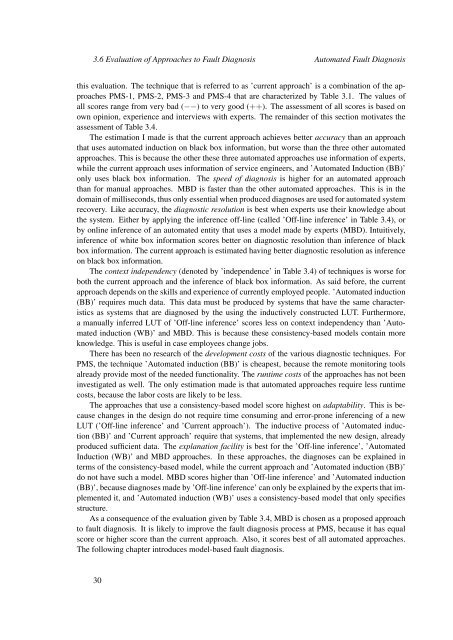pdf download - Software and Computer Technology - TU Delft
pdf download - Software and Computer Technology - TU Delft
pdf download - Software and Computer Technology - TU Delft
Create successful ePaper yourself
Turn your PDF publications into a flip-book with our unique Google optimized e-Paper software.
3.6 Evaluation of Approaches to Fault Diagnosis Automated Fault Diagnosis<br />
this evaluation. The technique that is referred to as ’current approach’ is a combination of the approaches<br />
PMS-1, PMS-2, PMS-3 <strong>and</strong> PMS-4 that are characterized by Table 3.1. The values of<br />
all scores range from very bad (−−) to very good (++). The assessment of all scores is based on<br />
own opinion, experience <strong>and</strong> interviews with experts. The remainder of this section motivates the<br />
assessment of Table 3.4.<br />
The estimation I made is that the current approach achieves better accuracy than an approach<br />
that uses automated induction on black box information, but worse than the three other automated<br />
approaches. This is because the other these three automated approaches use information of experts,<br />
while the current approach uses information of service engineers, <strong>and</strong> ’Automated Induction (BB)’<br />
only uses black box information. The speed of diagnosis is higher for an automated approach<br />
than for manual approaches. MBD is faster than the other automated approaches. This is in the<br />
domain of milliseconds, thus only essential when produced diagnoses are used for automated system<br />
recovery. Like accuracy, the diagnostic resolution is best when experts use their knowledge about<br />
the system. Either by applying the inference off-line (called ’Off-line inference’ in Table 3.4), or<br />
by online inference of an automated entity that uses a model made by experts (MBD). Intuitively,<br />
inference of white box information scores better on diagnostic resolution than inference of black<br />
box information. The current approach is estimated having better diagnostic resolution as inference<br />
on black box information.<br />
The context independency (denoted by ’independence’ in Table 3.4) of techniques is worse for<br />
both the current approach <strong>and</strong> the inference of black box information. As said before, the current<br />
approach depends on the skills <strong>and</strong> experience of currently employed people. ’Automated induction<br />
(BB)’ requires much data. This data must be produced by systems that have the same characteristics<br />
as systems that are diagnosed by the using the inductively constructed LUT. Furthermore,<br />
a manually inferred LUT of ’Off-line inference’ scores less on context independency than ’Automated<br />
induction (WB)’ <strong>and</strong> MBD. This is because these consistency-based models contain more<br />
knowledge. This is useful in case employees change jobs.<br />
There has been no research of the development costs of the various diagnostic techniques. For<br />
PMS, the technique ’Automated induction (BB)’ is cheapest, because the remote monitoring tools<br />
already provide most of the needed functionality. The runtime costs of the approaches has not been<br />
investigated as well. The only estimation made is that automated approaches require less runtime<br />
costs, because the labor costs are likely to be less.<br />
The approaches that use a consistency-based model score highest on adaptability. This is because<br />
changes in the design do not require time consuming <strong>and</strong> error-prone inferencing of a new<br />
LUT (’Off-line inference’ <strong>and</strong> ’Current approach’). The inductive process of ’Automated induction<br />
(BB)’ <strong>and</strong> ’Current approach’ require that systems, that implemented the new design, already<br />
produced sufficient data. The explanation facility is best for the ’Off-line inference’, ’Automated<br />
Induction (WB)’ <strong>and</strong> MBD approaches. In these approaches, the diagnoses can be explained in<br />
terms of the consistency-based model, while the current approach <strong>and</strong> ’Automated induction (BB)’<br />
do not have such a model. MBD scores higher than ’Off-line inference’ <strong>and</strong> ’Automated induction<br />
(BB)’, because diagnoses made by ’Off-line inference’ can only be explained by the experts that implemented<br />
it, <strong>and</strong> ’Automated induction (WB)’ uses a consistency-based model that only specifies<br />
structure.<br />
As a consequence of the evaluation given by Table 3.4, MBD is chosen as a proposed approach<br />
to fault diagnosis. It is likely to improve the fault diagnosis process at PMS, because it has equal<br />
score or higher score than the current approach. Also, it scores best of all automated approaches.<br />
The following chapter introduces model-based fault diagnosis.<br />
30
















